Ten Reasons Yoga is Good For You is a nicer title than ten reasons that yoga might be bad for you so here is last week’s list inverted. Personally, yoga changed my life. My father’s favorite way to describe me was that I lacked stick-to-itiveness (see reason #1), and for a long while he was right. I wandered aimlessly before I found my way to a yoga mat and almost twenty years later i am still at it, much to my own surprise.
1. Yoga and the Brain
 Study after study (email for a list) has shown the positive effects of yoga on brain and body function. Positive effects have been shown with—chronic back pain, depression, diabetes, menopause, stress management and relaxation, asthma, heart disease, blood pressure, cholesterol, etc.
Study after study (email for a list) has shown the positive effects of yoga on brain and body function. Positive effects have been shown with—chronic back pain, depression, diabetes, menopause, stress management and relaxation, asthma, heart disease, blood pressure, cholesterol, etc.
The human nervous system runs the show that is our life. We are endlessly seeking an equilibrium between relaxation (parasympathetic nervous system), and excitation (sympathetic nervous system). In our hyperkinetic modern world excitation tends to win the day to the detriment of us all.
Cultivating relaxation in any form serves you and everyone around you in our quest for balance.
2. Inversions
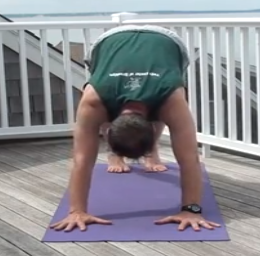 While I no longer teach headstand, (headstand and shoulderstand – are much more advanced than they are given credit for— I believe in turning the body upside down. Inversions are ridiculously good for you. Down dog is an inversion and I teach handstand and my beloved L-shapes in almost every class. Some benefits of inverting are:
While I no longer teach headstand, (headstand and shoulderstand – are much more advanced than they are given credit for— I believe in turning the body upside down. Inversions are ridiculously good for you. Down dog is an inversion and I teach handstand and my beloved L-shapes in almost every class. Some benefits of inverting are:
- Oxygenating the blood and improving circulation.
- Organic massage- going upside down pumps all of our internal organs in a different and stimulating direction.
- Balance is one of the keys to ageing well and working on balance upside down is extremely helpful.
- Fear dominates the lives of so many people- watching students use their handstand practice as a means of processing the fear response has always been amazing and inspiring to me.
- We shrink a bit over the course of each day as our spinal column compresses. Compressing it upside down actually has the effect of decompressing it when we go back to upright.
3. A Tucked Pelvis And Tadasana
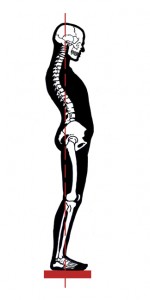 Tadasana is the foundation pose of many yoga styles, and a great place to learn to un the-tuck your pelvis. Repetition is the key to changing posture and movement patterns. It might not be so easy to focus on changing your posture while working, making dinner, or while doing homework but a daily yoga practice is the perfect environment for making incremental yet permanent changes to our bodies.
Tadasana is the foundation pose of many yoga styles, and a great place to learn to un the-tuck your pelvis. Repetition is the key to changing posture and movement patterns. It might not be so easy to focus on changing your posture while working, making dinner, or while doing homework but a daily yoga practice is the perfect environment for making incremental yet permanent changes to our bodies.
Find the proper placement of the pelvis and make sure to keep it in the right place throughout your practice and your body will start to change in other environments as well.
It is essential to stop tucking our pelvises.
4. Having Excessively Loose Joints (Hyper-Mobility)
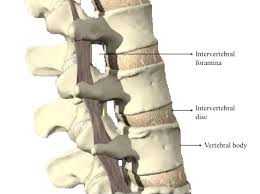 Loose people need yoga more than most. But they have to be careful about how far they go.
Loose people need yoga more than most. But they have to be careful about how far they go.
They just need to know that they are loose and know how to work with it.
In my case I was always complimented on how deep and easily I could do pigeon pose and other such hip openers.
It took me ten years to realize that this was because my piriformis (the muscle we stretch in pigeon) had no tone and was ridiculously weak.
What I, and many of my teachers, thought was good turned out to be less than optimal but once I became aware of it my life changed as my practice changed. Don’t expect your teachers to figure this out for you—get to know body and your self and watch the miracle of yoga unfold as you consciously rebuild your body.
5. Carpal Tunnel Syndrome And Downward Dog
 Most carpal tunnel issues emanate from the neck and basic postural corrections are key to alleviating the injury but as I wrote last week many people with carpal tunnel syndrome don’t know the anatomy of their issue. There is a tunnel formed by the carpal bones of the wrist that the median nerve passes between.
Most carpal tunnel issues emanate from the neck and basic postural corrections are key to alleviating the injury but as I wrote last week many people with carpal tunnel syndrome don’t know the anatomy of their issue. There is a tunnel formed by the carpal bones of the wrist that the median nerve passes between.
If you learn how to bare weight correctly through the shoulders, arms and hands you will can go a long way towards alleviating carpal tunnel issues. Any time the hands are on the floor their balanced action should creating a tunnel for clear passage of the median nerve to travel through to the hand. This link shares an affective technique for creating space in the carpal tunnel.
6. Weak Core Muscles And Wheel
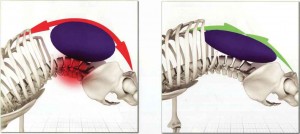 The discipline it takes to remain grounded in your feet when going into wheel pose will build your core in a beautiful way. I watch people in class that are simply unwilling to move at the pace appropriate for their practice. Thrusting up into wheel pose by turning out the feet and tucking the pelvis will come back to haunt anyone who insists on doing it that way.
The discipline it takes to remain grounded in your feet when going into wheel pose will build your core in a beautiful way. I watch people in class that are simply unwilling to move at the pace appropriate for their practice. Thrusting up into wheel pose by turning out the feet and tucking the pelvis will come back to haunt anyone who insists on doing it that way.
The opposite is true as well. Commit to going up into full wheel only when you can do so with ease of breath and body and your core will be built with beautiful balance.
A yoga practice that focuses on building strength in the abdominals, specifically transverse abdominis first, followed by the rectus abdominis once the transverse is working well, is going to both facilitate wheel pose, protect the lower spine, and making aging a more amenable process.
7. The Shoulders in Chaturanga
 I try not to be a cranky yoga teacher but sometimes I find it to be a difficult pursuit.
I try not to be a cranky yoga teacher but sometimes I find it to be a difficult pursuit.
Mirror neurons (posts coming soon) and the empathetic effect they have on the body fascinate me.
Watching students pass through chaturanga into upward facing dog over and over with a thought to movement rather than alignment hurts me.
Highlighting discipline (the theme here?) and balance seem way more interesting than emphasizing chaturanga after chaturanga in the search for flow and sweat. I love the power of chaturanga but I often wonder about the motivation that people bring to their practice.
Life can wreak havoc on our shoulders. The yoga practice can either hurt or heal them.
I often begin class with three shoulder/trunk stretches (here, here & here). Watching these stretches unfold from the front of the room is amazing. After each one, students are shrugging, turning and doing anything else that can shake off the intensity of what we’ve just done.
8. You Do Both Sides Of A Pose With The Same Gusto When One Side Is A Lot Tighter Than The Other.
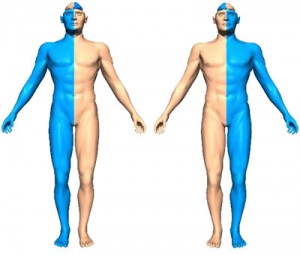 Everyone’s practice means something different to them. And far be it from me to tell people what to do (hah!). But yoga is not translated as union for no reason—the yin and the yang, the sun and the moon, the male and the female, and most importantly for me, the left and right side of your body.
Everyone’s practice means something different to them. And far be it from me to tell people what to do (hah!). But yoga is not translated as union for no reason—the yin and the yang, the sun and the moon, the male and the female, and most importantly for me, the left and right side of your body.
Get to know yourself. Honor yourself and then do your best to bring your two halves into balance.
9. Breathing Fully
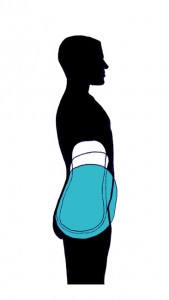 There were some interesting responses to my desire for people to breath into the belly.
There were some interesting responses to my desire for people to breath into the belly.
The idea for my walking program developed out of a desire to help people take their yoga practice off the mat into daily life. One of the hardest things to teach people when it comes to changing movement patterns is the unconscious initiation of movement coming from a lift of the front of the rib cage.
When we breathe the entire ribcage is meant to open—front and back.
The standard instructions in yoga and life are to stand up straight, open the chest and take the arm bones back. These actions tend to begin in the front of the body way more than the back. If I had to pick one bone with yoga it would be its difficulty in building the muscles of the back of the body. This is why I love L-shaped inversions so much. They are all about accessing and developing the layers of back muscle that can be hard to find.
The search for depth in so many poses tends to come at the expense of a full breath.
Whether it is bringing the arms over head, making extended side angle or triangle deeper, or going further in wheel, the focus has to be on maintaining a full breath which can only happen with a balanced and well aligned trunk. It returns to the issue of discipline and the willingness to go farther only when moving correctly.
Asana yoga is nothing more than a practice of breath awareness meant to set us up for a meditation practice. I often say the only reason to become more advanced in the physical practice is to challenge the breath so that we can breathe quietly and smoothly no matter how difficult the physical action.
10. Yoga Is A Really Fun Group Activity.
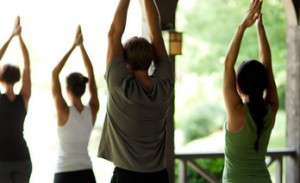 While the practice of yoga, at its root, is meant to be an exchange of one teacher to one student – a guru/disciple dynamic that has only been subverted in the last hundred years— I have no illusions about my place in the spiritual hierarchy. I am not living in search of enlightenment. As Jewish boy from Brooklyn with no religious background to speak of, I am deeply rooted in the corporeal world and not really looking for a way out.
While the practice of yoga, at its root, is meant to be an exchange of one teacher to one student – a guru/disciple dynamic that has only been subverted in the last hundred years— I have no illusions about my place in the spiritual hierarchy. I am not living in search of enlightenment. As Jewish boy from Brooklyn with no religious background to speak of, I am deeply rooted in the corporeal world and not really looking for a way out.
In that context, hanging out in a room with a bunch of like-minded people could not be more fun. Yoga is more about kindergarten than transcendence for me. We play around with mats and blankets and then take a short nap when we are done.
I’m pretty sure that I read a quote somewhere that said the adult life is nothing more than the search for a return to childhood innocence. Yoga is the closest thing I have found to take me in that direction.
And just for good measure…
11. Learn To Be Your Own Teacher
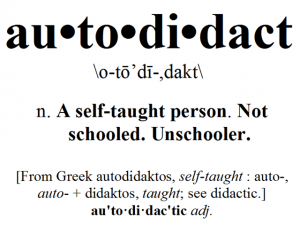 Be your own teacher. This is becoming more and more difficult in a world that is more and more geared towards conformity. Try to develop the ability to think outside the box in any way that you can. Aside from that I am reprinting last week’s section on teaching. It seemed to resonate quite a bit.
Be your own teacher. This is becoming more and more difficult in a world that is more and more geared towards conformity. Try to develop the ability to think outside the box in any way that you can. Aside from that I am reprinting last week’s section on teaching. It seemed to resonate quite a bit.
It is all too easy to become a yoga teacher and, while there are many great ones out there who truly know their stuff and teach beautifully precise and informed classes, there are equally as many who aren’t. The truth of the yoga world is that there are so many yoga centers and so many yoga classes. Hiring practices, in my mind, should be akin to becoming a college professor – publish or perish! However, many teachers are hired on the basis of personality and looks (both valid attributes) and how many people they can put in the room (it is a business after all).
It is the student’s responsibility to be discerning. Just because someone stands at the front of the yoga room doesn’t mean that they have a clue about telling you what to do with your body. When I am teaching I often like to say that it is my job to be confident and act as if I am correct. It would be ludicrous if I didn’t. And, while I genuinely think I am right about everything… maybe I’m not.
Yoga changed my life in every way for the better. I met my wife on the mat, found my profession and have met some of the sweetest, warmest and most creative people in the yoga room. It has been a blessing beyond compare and I couldn’t imagine a life without it. And it led me to develop my CoreWalking Program.
